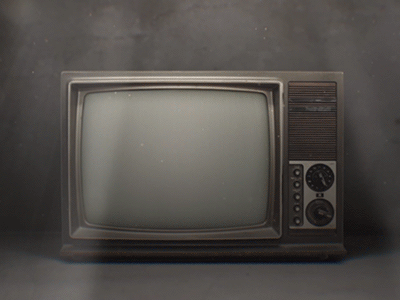
Susan Hiller
Douglas Davis
Nam June Paik
Jimmy Kuehnle
Bruce Nauman
Darsha Hewitt
Jeff Wall
Gretchen Bender
Wojtek Ulrich
Dara Birnbaum
James Connolly and Kyle Evans
Joel Holmberg
Dyke TV
Paul Pfeiffer
Adrian Piper
Jan Bark & Erkki Kurenniemi
Hiwa K
Christo
Antonio Muntadas
Seo Young Chang
TVTV
Zhang Xiangxi
Leopold Kessler
_______________
Susan Hiller Channels (2013)
‘Susan Hiller’s Channels is an audio-visual conglomeration of near death experience (NDE) narrations told through a full-scale installation of television monitors. Whether these monitors simply house these personal stories or act as a portal through which they emerge isn’t clear. It doesn’t need to be. Bathed in the glowing light of these numerous screens, numerous voices come forth with one eventually becoming the clearest. Hours of recantations are housed here, in these screens, in this room. It’s the near-ghost in the machine.’
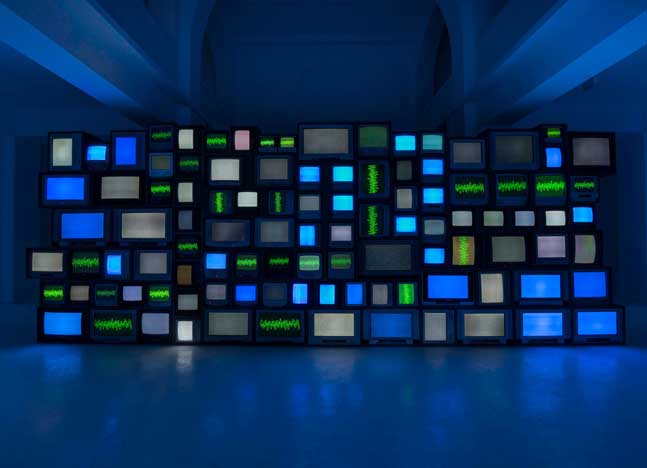
_______________
Douglas Davis Images from the Present Tense (1971)
‘Douglas Davis tackled video in a very thoughtful manner: both by questioning the medium and by a theoretical discourse on its possibilities. For Davis, the issue of the advantages of this new technology arose in view of his most important objective: to allow communication between people by bridging spatial and temporal distances. His encounters with Paik, Beuys, Acconci, Campus, Baldessari and concept artists were important for Davis. Like Paik and others, Douglas Davis was involved in the manipulation, refusal and rejection of television, as for example in his installation for Project ’74 in Cologne, Images for the Present Tense, in which he pointed the television set towards the wall, with a hissing, brightly flickering screen, and used it as a source of light or reflection.’

_______________
Nam June Paik TV Crowns (1965)
‘The patterns were created using tone generators and an amplifier in conjunction with the televisions themselves.’
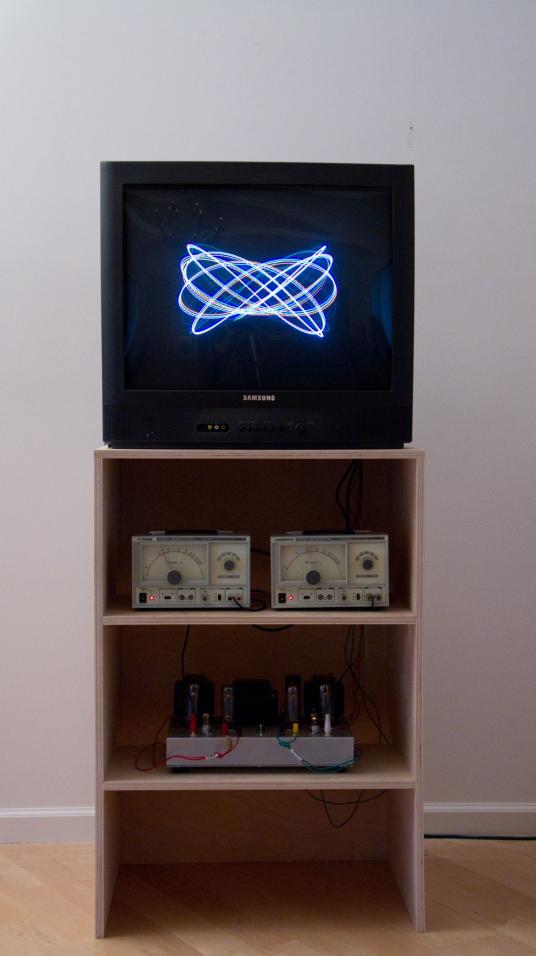
_______________
Jimmy Kuehnle Loud and Clear (2006)
‘I constructed a pulpit like structure containing, sound amplification equipment, a video projection screen, hidden cameras, and two towers of televisions. Similar to previous performances, costume played a major role. My head was completely enclosed in a fabricated, opaque plastic box. In addition to my head and brain, the box housed cameras and microphones pointed towards my face. The signal from these cameras and microphones was delivered to the projection screen and sound amplification equipment on the pulpit. This was how I communicated with the audience without being able to see the audience directly.’ — JK

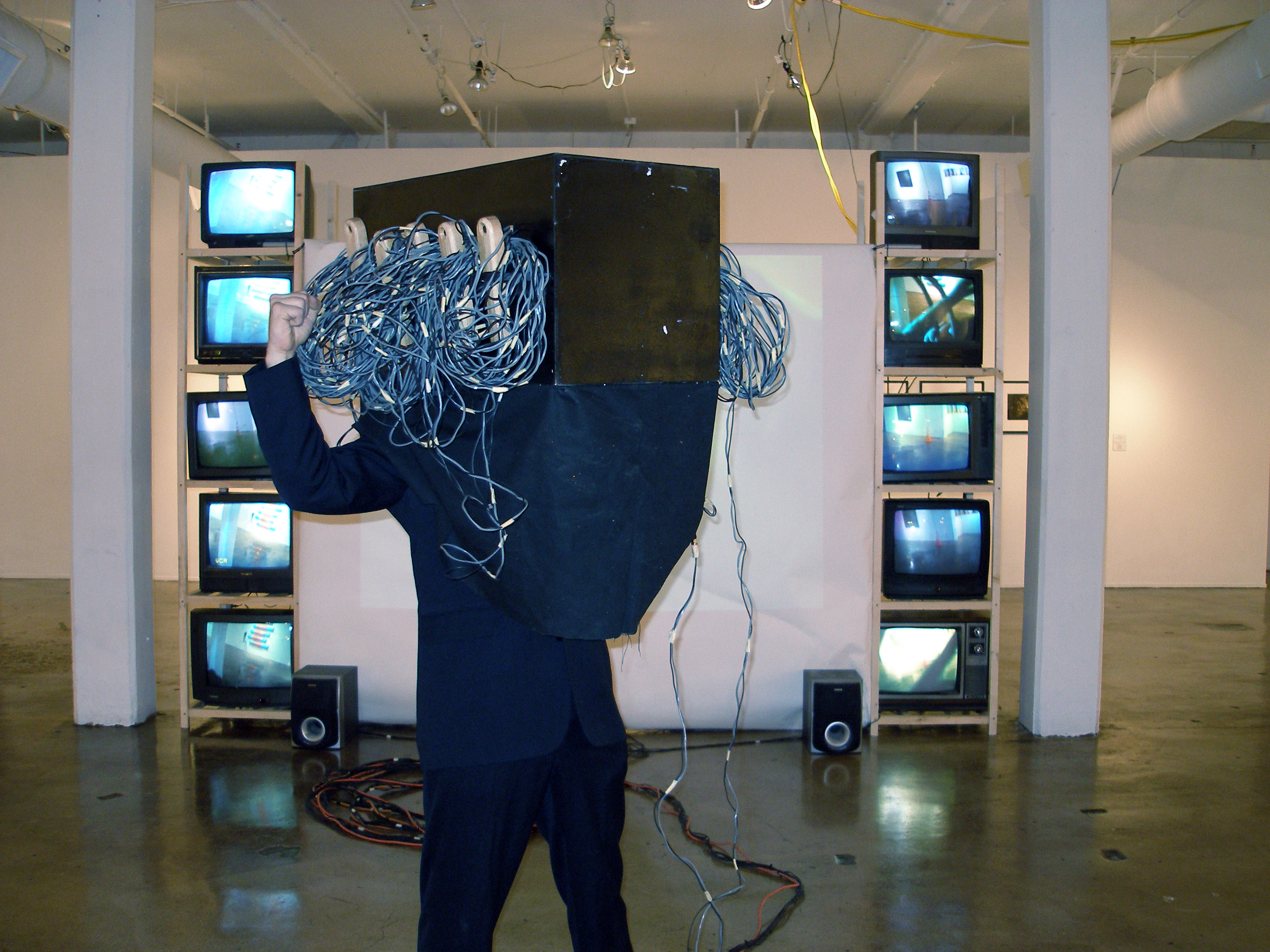

_____________
Bruce Nauman Lip Sync (1969)
‘In Bruce Nauman’s Lip Sync, a video camera is turned upside down and held in a tight close–up on the filmmaker’s face as he speaks the words of the title. The words, which at first emerge in a low murmur, quickly grow louder and more distinct, overwhelming the sound track and creating a rhythmic beat. The sound and image fall in and out of synchronization as the viewer tries vainly to connect the movement of Nauman’s lips with his voice. This struggle intensifies as the work progresses, keeping the viewer in a state of nervous tension.’

______________
Darsha Hewitt The Electrostatic Bell Choir (2012)
‘Everyone is familiar with the curious effects of static electricity. Freshly laundered clothing clings together if one neglects to toss an anti-static sheet into the dryer, a balloon magically sticks to a wall after being rubbed over a head full of hair, an irritating shock transmits from one person to the next while shaking hands on a dry winter’s day. Inspired by this peculiar phenomenon The Electrostatic Bell Choir plays with static electricity in order to harvest its kinetic potential and use it as the driving force in the artwork.’
______________
Jeff Wall Boy on TV (1989)
Cibachrome print
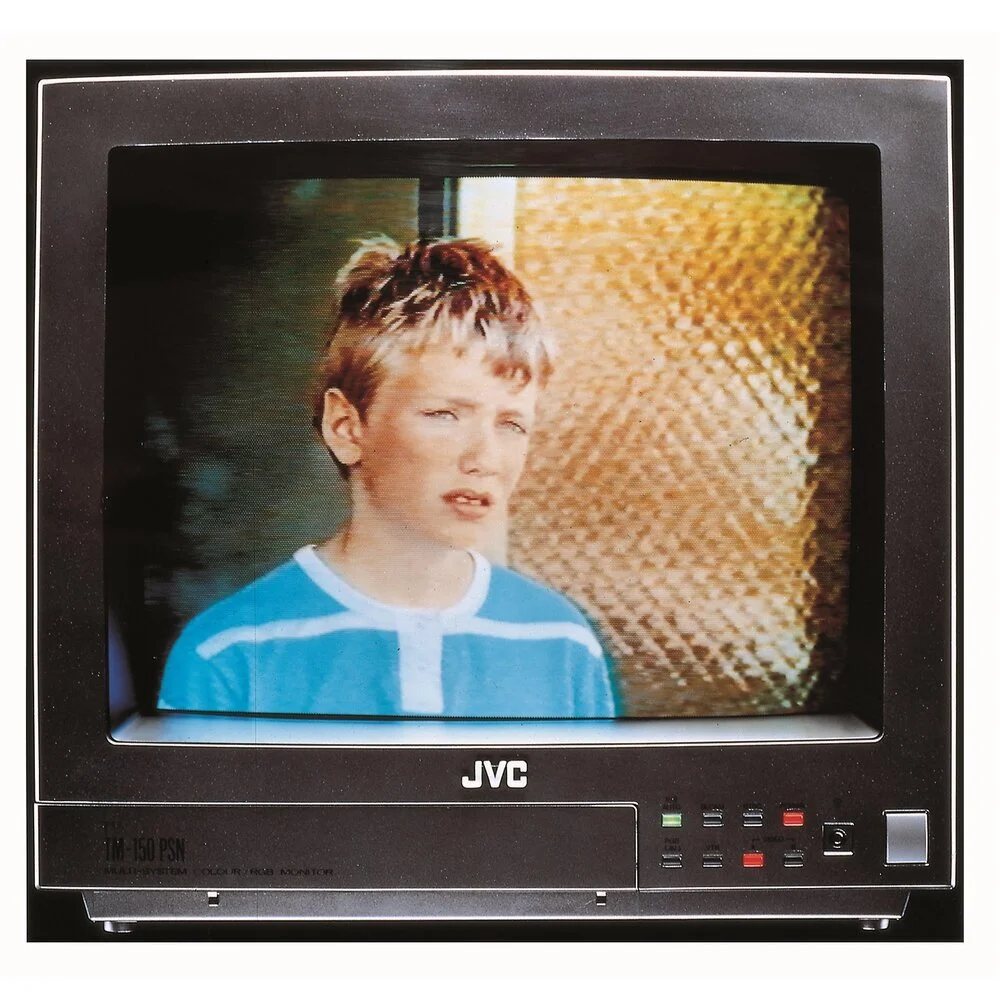
_______________
Gretchen Bender Reality Fever (1983)
‘An early, single-channel version of Bender’s video collages, one with found, created, and manipulated imagery, including a Folgers coffee commercial, a children’s superhero cartoon, and Stanley Kubrick’s 2001: A Space Odyssey.’
________________
Wojtek Ulrich TV Mirror (Irreversible) (2011)
‘2 tv screens and 2 mirrors, DVD movies: Irreversible by Gaspar Noe and Amores Peros by Alejandro Gonzalez Inaritu. ‘A movie being played, a document, a live coverage, anything on TV, shows, films, news, all the illusion and created vision that is reflected, the image in the mirror, becomes the truth in the mirror, “almost” without any “distance” for the maximum “fidelity to the events” and, as a matter of fact, due to the 1:1 fidelity, we get the truth, we get what said fidelity creates in a given situation.’ — WU
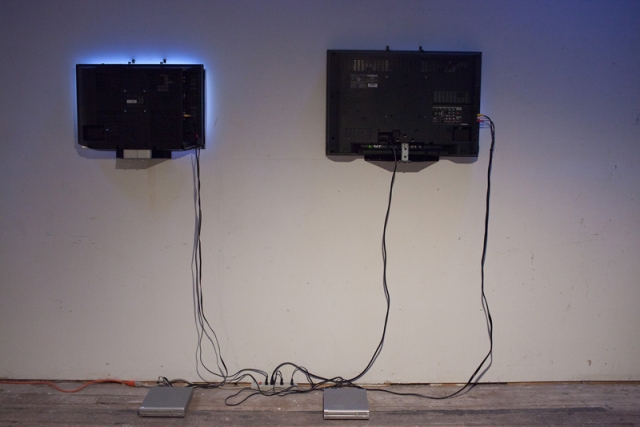
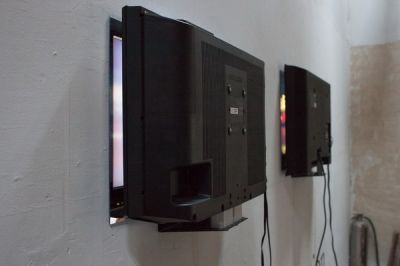

________________
Dara Birnbaum Technology/Transformation: Wonder Woman (1978-79)
‘Opening with a prolonged salvo of fiery explosions accompanied by the howl of a siren, Dara Birnbaum’s Technology/Transformation: Wonder Woman shows the secretary Diana Prince changing again and again into the superhero Wonder Woman. By isolating and repeating the moment of transformation – spinning figure, arms outstretched – this landmark work in the history of video and appropriation unmasks the language of television, the mechanisms of gender representation and the technology at the heart of the metamorphosis.’

________________
James Connolly and Kyle Evans Cracked Ray Tube (2012)
‘Cracked Ray Tube is a collaborative realtime installation and performance project with Kyle Evans that breaks and disrupts the interfaces of analog televisions and computer monitors through hybridized analog and digital systems to produce flashing, screeching, wobbulating, self-generated electronic noise and video. The project is heavily influenced by the Chicago Dirty New Media scene, and was created under the COPY-IT-RIGHT philosophy, with plans for all of our custom hardware shared online in PDFs and taught in workshops.’
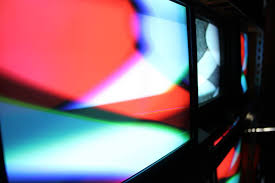

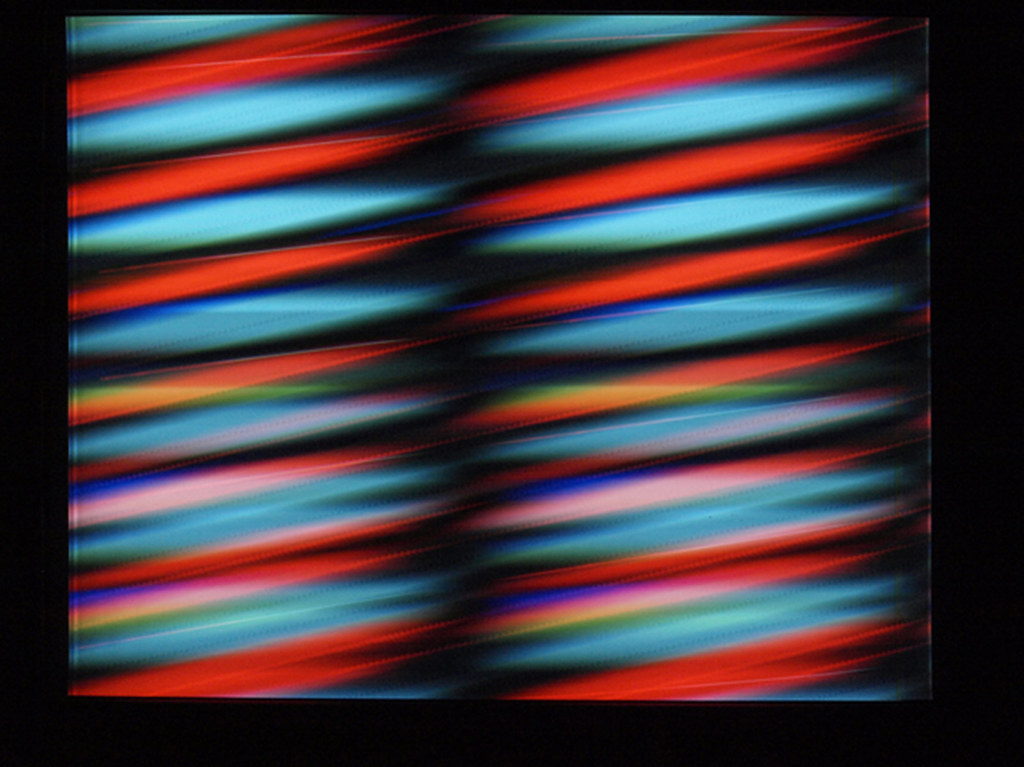
________________
Joel Holmberg GOTcredits+expose (2014)
_______________
Ana María Simo, Linda Chapman, Mary Patierno Dyke TV (1993-2005)
‘Dyke TV was founded and created by Ana María Simo, playwright and cofounder of Lesbian Avengers; Linda Chapman, theater director and producer; and Mary Patierno, independent film and video maker. The first episode aired on June 8, 1993, in New York City. The last episode aired in 2005. Dyke TV produced national documentary television programming. New episodes were produced weekly for the shows 12 years on air, and ran for a half hour. In January 2005, the last five episodes ran for an hour. It was broadcast on nationwide cable TV weekly from 1993 to 2005, reaching over 6.5 million households nationwide, as well as being screened at national and international film festivals. In 1994, Dyke TV was awarded a Hometown Video Festival Award.’
_______________
Paul Pfeiffer Caryatids (2009)
‘Caryatids present video footage of solitary boxers being punched in slow motion. Intensive editing and computer manipulation has erased the opponent, focusing the viewer’s attention on the brutal impact inflicted by the invisible assailant.’

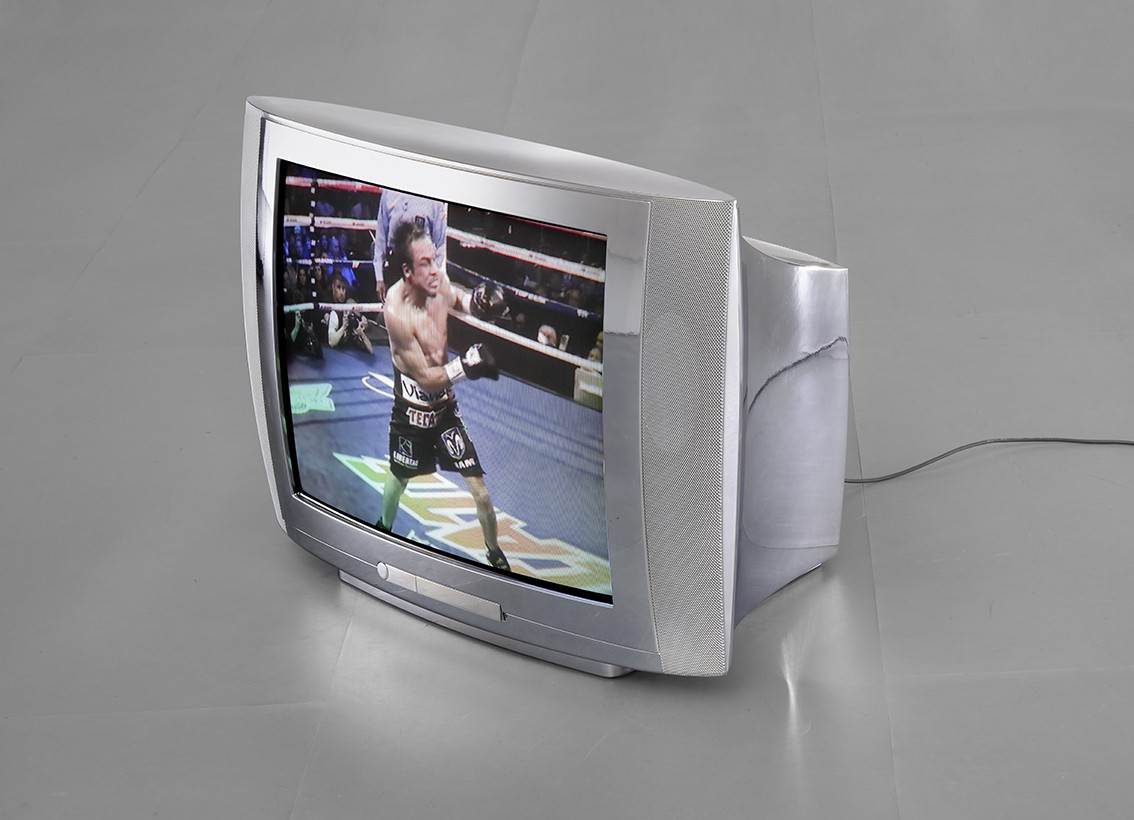

_________________
Adrian Piper Mythic Being (1973)
‘Adrian Piper’s early performance and photography work is often referred to but rarely seen. For the ‘Mythic Being’ series (1972-75), shown complete here for the first time (and archived usefully on the website, www.thomaserben.com), Piper disguised herself as an androgynous, racially indeterminate young man, dressed in black T-shirt and flared jeans, big sunglasses, an Afro wig and a Zapata-ish moustache, often smoking a cigarette. She documented a series of public and private performances.’

______________
Jan Bark & Erkki Kurenniemi Spindrift (1966)
‘In 1965, Swedish composer/musician Jan Bark proposed an experiment for a new kind of ‘music for black-and-white TV’. Bark’s friend Erkki Kurenniemi programmed the animations.’
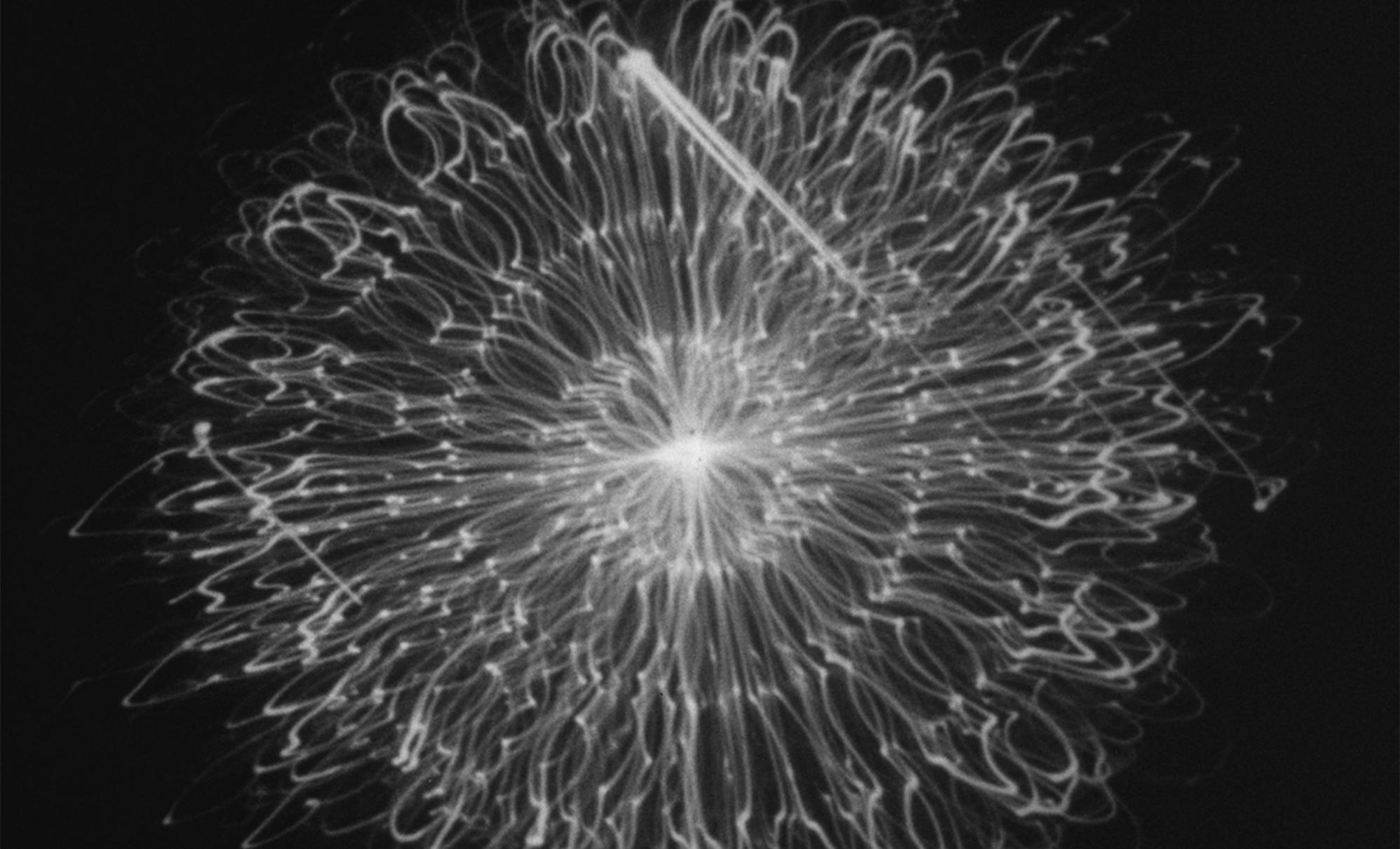
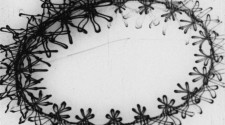
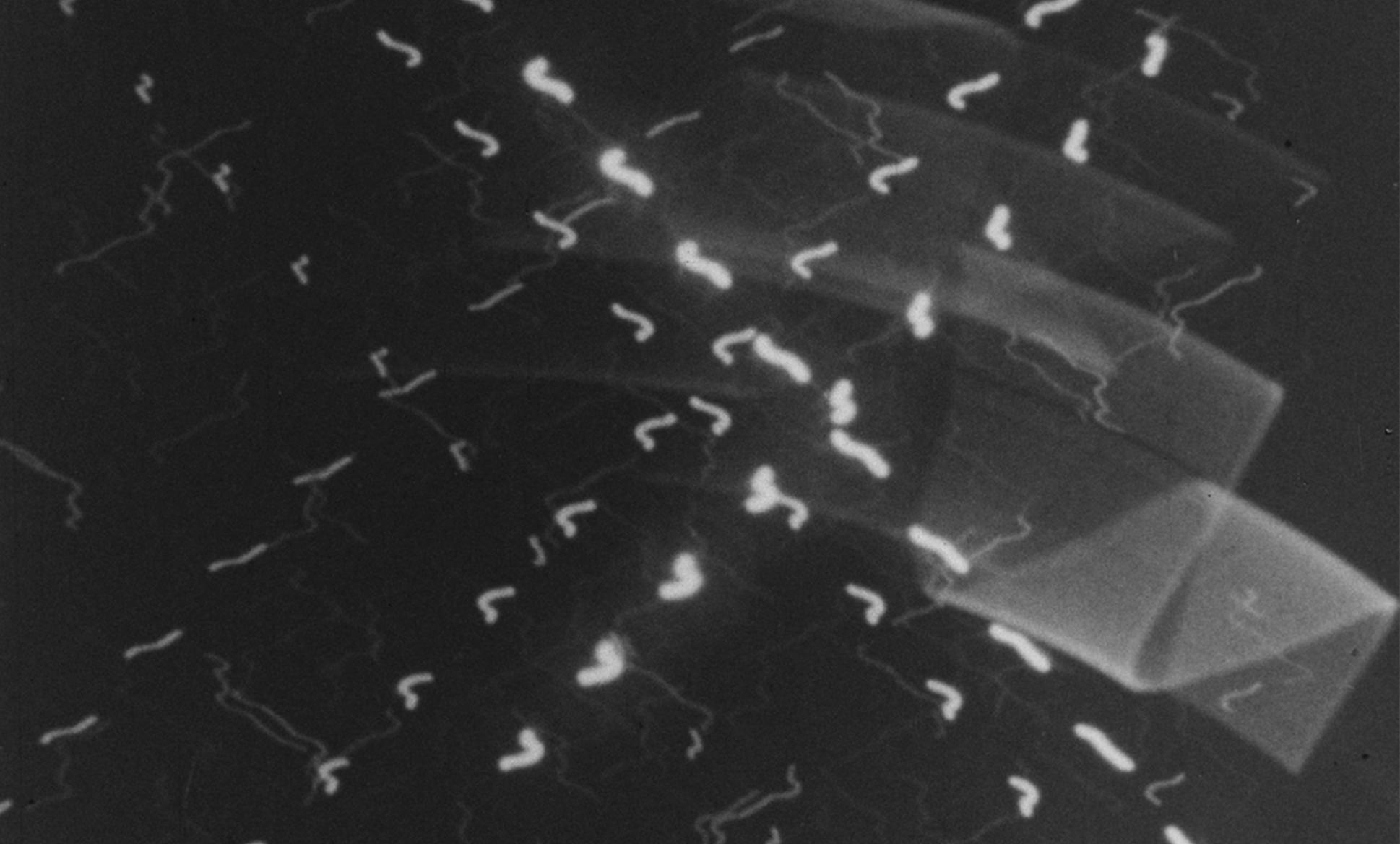
_______________
Hiwa K My Father’s Color Periods (2012)
‘”Tonight the film will be broadcast in color” – a rumor spread in 1979 among people who believed that the state owned TV station would show the film in color despite of the fact that the TV´s were still black &white. Unlike in cities with Arab inhabitants the majority of the people in Kurdish area of Iraq still had no reach of color TV sets. So my father would cut and stick a sheet of cellophane on the screen of our TV at home. Some times it stayed one week until he switched to another color. We used to watch films, music videos and all other programs, once in blue, pink, green and yellow and so on. Later that he started also with dividing the screen into two, three or four squares with different color in each. Eventually he began with stripes and other possible forms. We were watching the figures walking from blue to green, though yellow, purple to pink. In a while the entire city employed it with their black and white TVs going through the blue, then to pink, yellow phases and so on.’ — HK
______________
Christo Wrapped Television Set (1996)
polythene, rope and TV set
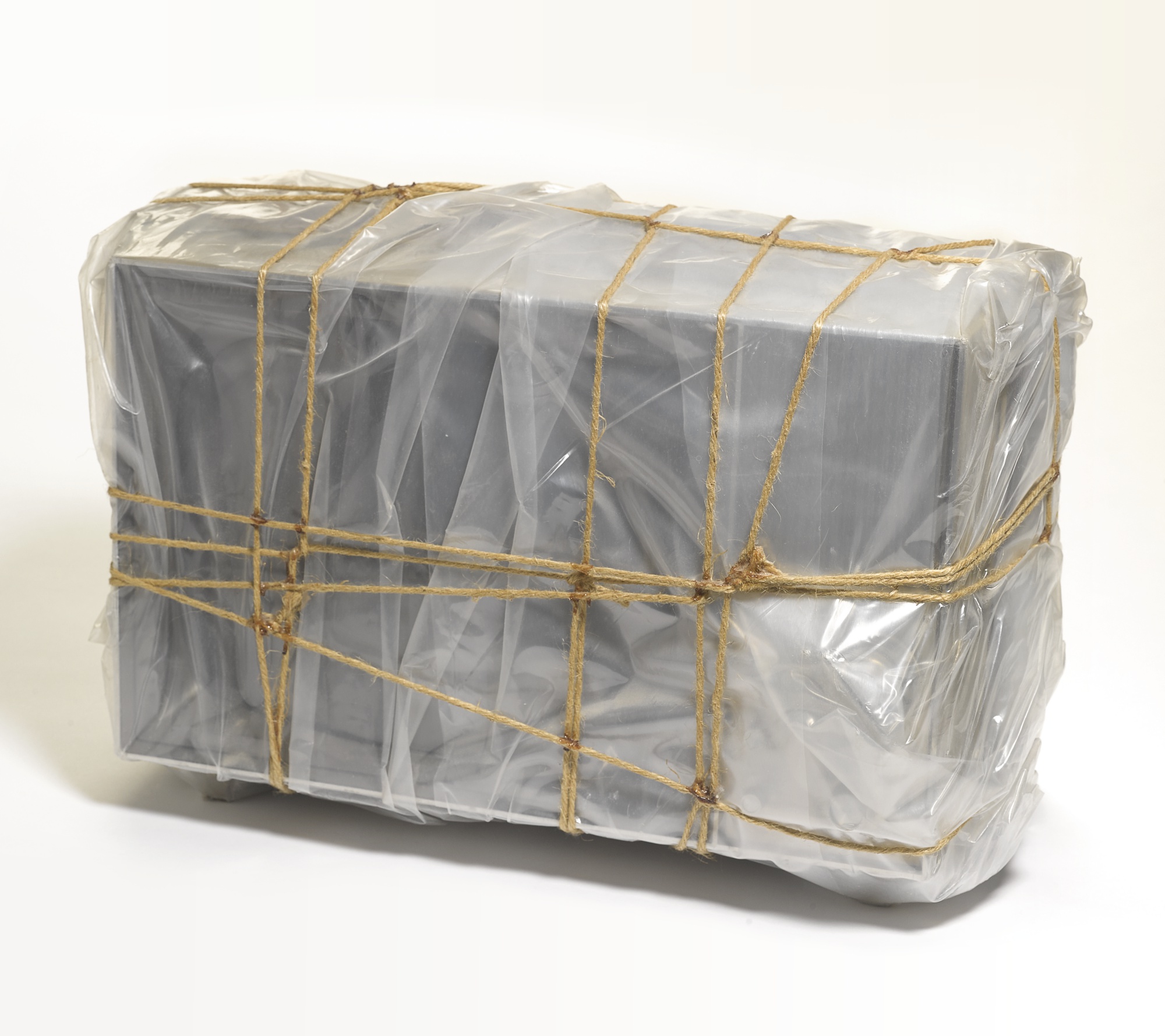
______________
Antonio Muntadas Video is television? (1989)
‘Playing back “visual quotations” of everything from Poltergeist to Blade Runner, Muntadas rescans the surface of the monitor, questioning the “nature” of media—film, television, video, and image. Television emerges as the medium to eat all mediums, raising the question: Is it possible,within the context of television, to tell art from life or fact from fiction? An endless row of generic TV monitors visually evokes a hall of mirrors as the expression of the cultural homogeneity and bland abundance achieved through the dominant medium of the late 20th century. Music composed by Glenn Branca.’
______________
Seo young Chang The Well (2010)
‘When the sun set, the monster crawled out of the well and ate town people. …’
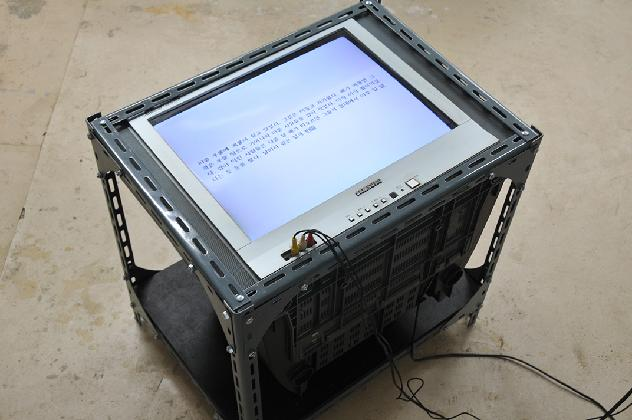
_______________
TVTV (Top Value Television) Looks at the Oscars (1976)
‘TVTV (short for Top Value Television) was a San Francisco-based pioneering video collective founded in 1972 by Allen Rucker, Michael Shamberg, Tom Weinberg, Hudson Marquez and Megan Williams. Shamberg was author of the 1971 “do-it-yourself” video production manual Guerrilla Television. Over the years, more than thirty “guerrilla video” makers were participants in TVTV productions. They included members of the Ant Farm: Chip Lord, Doug Michels, Hudson Marquez and Curtis Schreier; the Videofreex, Skip Blumberg, Nancy Cain, Chuck Kennedy, and Parry Teasdale. TVTV pioneered the use of independent video based on wanting to change society and have a good time inventing new and then-revolutionary media, ½” Sony Portapak video equipment, and later embracing the ¾” video format.’
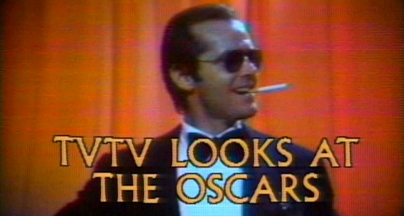
_________________
Zhang Xiangxi Tubes (2013)
‘Chinese artist Zhang Xiangxi uses old television sets to create intricately sculpted rooms. The sculptor’s meticulous craftsmanship results in intriguing and unconventional dioramas with a wonderful sense of depth. He manages to not only recreate furniture like desks and beds, but Xiangxi also mirrors the genuine messiness of a real room. Whether the artist is replicating his parents’ living room, his own chaotic studio, the littered interior of a train car, or his dream home, Xiangxi manages to capture the ambience of each environment. His attention to detail is evident through his line of carefully crafted work, which even uses materials from the objects they are mimicking. The artist says, “I like to closely observe daily life and work out how to make things.”’
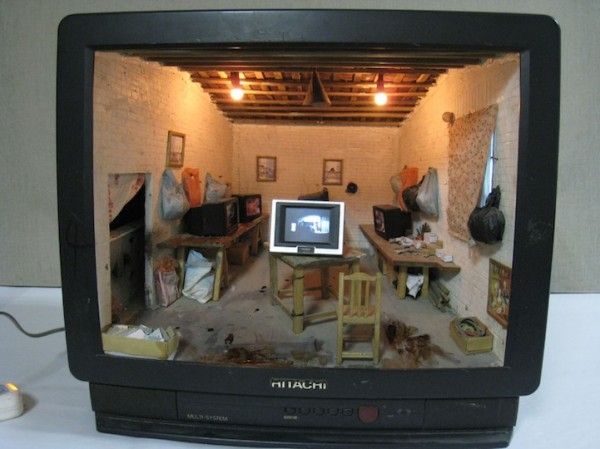
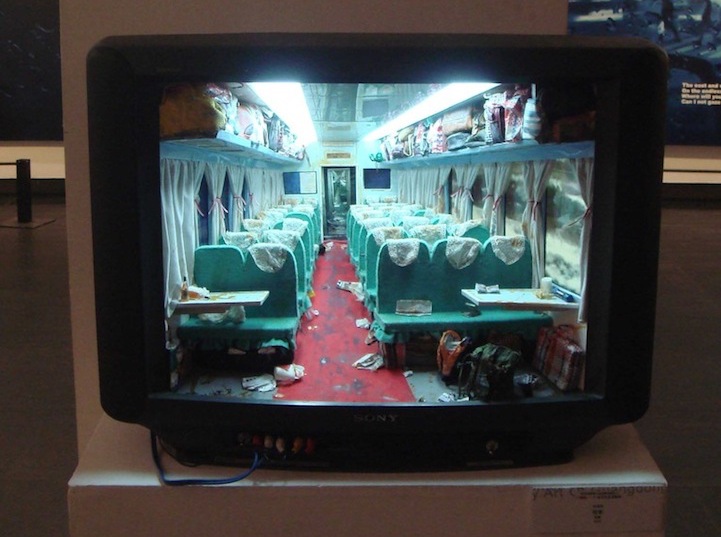
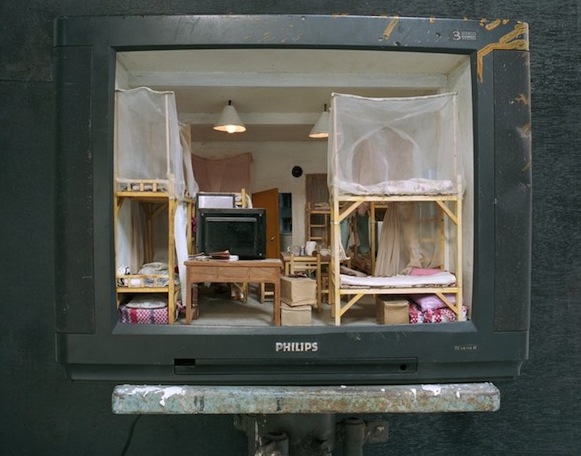


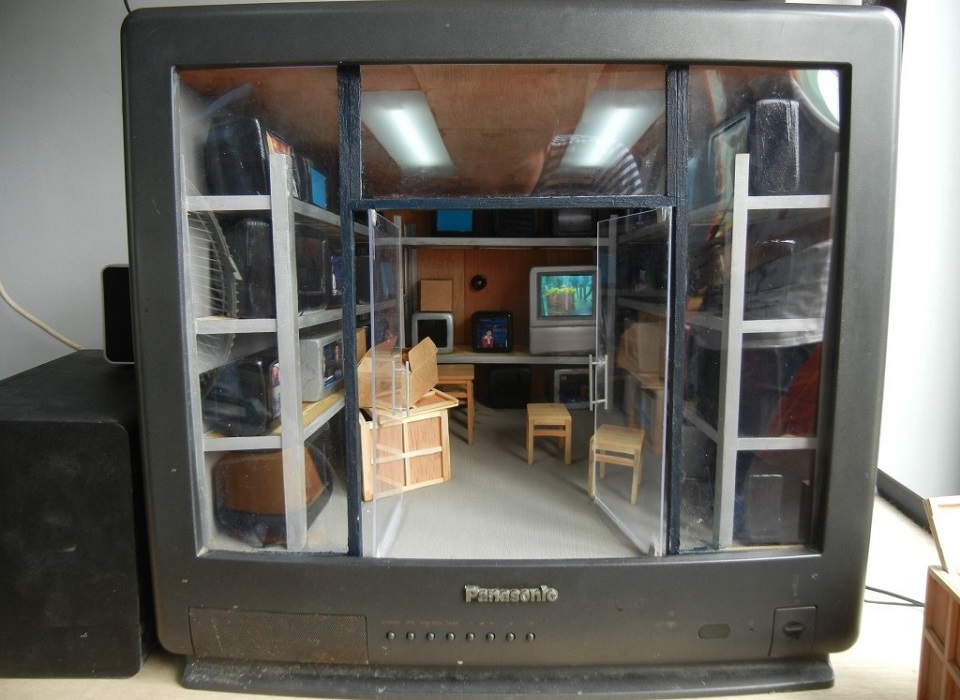
_________________
Leopold Kessler Hit TV (2001)
T’elevision is switched on/off by hitting on top.’
*
p.s. Hey. ** Laura, Howdy! Yeah, I don’t think I was born yet when they were friends or colleagues or whatever they were. I’m not remembering what you mean by ‘George music’? Trip was very good. Jet lag is def. here but I’m not sure how determined it is yet. ** Carsten, Hey, man. It was good. Lots of freeways and skyscrapers at least where I was staying. Way too warm for mid-November. But, yeah, good, pleasant. Everyone, Carsten has a new poem available for your reading delectation curtesy of the The Closed Eye Open, page 11, here. ** Dominik, Hi!!! Trip was good. The screening went great. An old friend of mine lives there and showed Zac and me the sights (Menil Collection, Rothko Chapel, the Citadel, Mexican food, etc.). And how motivating was the German yaoi for love? Love typing and thinking blearily at least for the moment, G. ** Charalampos, Okay, I’ll do my best to get to it asap. I’m not the right person to ask which E. White book would make one love him. Hi back from fuzzy, cold Paris. ** Bill, Hi. B. I want to see that Hujar film. I think maybe the distributor of ‘RT’ is going to release it here, in which case it should be easy. Houston did he assigned trick. ** Dr. Kosten Koper, Hello, sir. Lovely to see you up (for me) in Ghent. Thanks for the Wain riffing. ** Brendan, Hi, man. I did see your email in my box. I’ve just been traveling and junk like that and even further behind than usual. But I’ll jump on it asap. December & LA, here I come. Take care, bud. ** Sypha, Thanks for talking with darbz. ** Hugo, Hi! The literary establishment powers-that-be designated him as the big gay writer dude for reasons both obvious and unexplained, I guess. You take care too. ** Eric C., Thanks for your wordage to darbz, man. ** _Black_Acrylic, Hi, Ben. I don’t know about ‘the hell out of’ but I did enjoy it. Belated happy birthday, pal. I think I saw a pre-eaten festive b’day cake on Facebook or somewhere. What kind of flooring? Normal or eye-catching? ** Steeqhen, Hey. Rosalia remains a mystery to me, but for how long, I can not say. I saw the poster for that ‘Pillion’ film. And a thing about the one guy’s visible pierced dick. And that is all I know. A S/M-set rom-com is not an appealing idea, I must say. Your new story sounds good, and the title too. Did you finish it apropos the deadline? ** BTG, Hi. Interesting that it makes no sense. Why, if you can say? I guess for me after growing up in giant, messy Los Angeles, it seems very precise somehow. But I don’t speak French, so I’m missing probably everything deep and subtle. I find it immensely homey too. And I don’t think I’m particularly loved here even as far I can tell. ** jay, Hi, jay! Absurdly good! Congrats on the job. Is it interesting to describe or not? I’m good, the film stuff seems to be still going really well. But next week we have the release and all the reviews and all that stuff, so we’ll see if our luck hangs in here. Thanks, pal, great to see you. ** Steve, Hey. Yes, the festival and screening were very good. Cool people, cool scene. I had only been driven through Houston once as a kid. It does seem to have an LA-like sprawl so there was a kind of comfort to it for me. And no gun-toting MAGA people that I could see, but I stuck to the bohemian-ish parts. But I guess it’s a blue city. The third bluest city in Texas after Austin and Dallas, I was told. I suppose I could imagine a reason to see John Fogerty if I gave it some thought maybe. New episode! Everyone, Steve’s excellent radio show/podcast has a new episode up and incorporable. In his words, ‘My latest “Radio Not Radio” show is linked here. This one features Jon Camp, Fred Frith, Gwenifer Raymond, Sir Richard Bishop, Elizabeth Cotten, Steve Tibbetts, Muscle, Ameretat, Dick Move, The Urinals, Emily’s Sassy Lime, Lambrini Girls, Citric Dummies, Hüsker Dü, Squirrel Bait, Rosalia, Lea Bertucci, La Tene, Primitive Percussion Youth Orchestra, Yara Asmar, Necrophorus, Patricia Brennan, Vi, Soft Pink Truth and Eiko Ishibashi & Jim O’Rourke. ** Nicholas., *Shatter*: hope you’re okay. Well, it sounds like ‘Wicked’ was very inspiring, I must say. I’m just bleary over here. ** darbbzz⋆。°✩🎃✩°。⋆, No, no, thank you, maestro! It went great, I think. A major hit! Glad you got a rest from the job but just as glad that it’s being enjoyable. Me? I always get big time jet lag, so I’m just kind of out of it this morning, but it’s almost freezing cold here, which is great after way too warm/humid Houston. Friendship can be so great for one’s art making, for sure. You sound excellent, and at least you’re eating tofu. Houston does have a giant mouth, it’s true, it’s weird. ** Philip, Hi, Philip! Really good to meet you. Excuse my fogginess because I’m quite jet lagged this morning, but I guess I would say that being around fellow creatives involves a combo of IRL and online presences these days wherever you are. I grew up in LA, and, from what I can tell, there’s a very good scene there at the moment of writers and other sorts of artists with an energised scene of readings, bookstore events, writers groups, etc. There’s this young/new experimental theater scene going on, which is very odd, but that’s where a lot of energy seems to be. The thing with LA though is that it’s not as social a place as, say, NYC or even San Francisco. I personally like that because you also have a lot of alone time to write/work, but you do have to kind of organise your writer-fraternising time or center it around events, at least until you have a group of artist pals. It can feel a bit isolating there even if you do have good comrades. NYC is still an obvious place, and, sure, it’s not like it was, and everybody lives across the rivers rather than in Manhattan, but it’s still very alive. The scene around the Poetry Project is in a particularly vital stage these days, it seems to me, for instance. Otherwise, I don’t really know. When I was on Baltimore and Chicago recently to show our film, the scene in those places seemed pretty lively and exciting. Where do you live? Do you have a kind of ideal location in mind at all? ** HaRpEr //, Productive but forgettable: I don’t know why that sounds so appealing. Yeah, no interest in ‘Frankenstein’ on my end. I only watched plane films. ‘Ballerina’ was kind of fun after the first sort of boring half-hour or so. ** Uday, Hi. If that’s true try to prepare your life so the first couple of weeks of December are protected against stressfulness because that’s the next blog vacation. Your day certainly does sound most unpleasant, I’m so sorry, my friend. Kindness is the best. Kindness will save all of us. ** Okay. I’m restarting the blog by letting you ‘watch TV’ for a day. See you tomorrow.
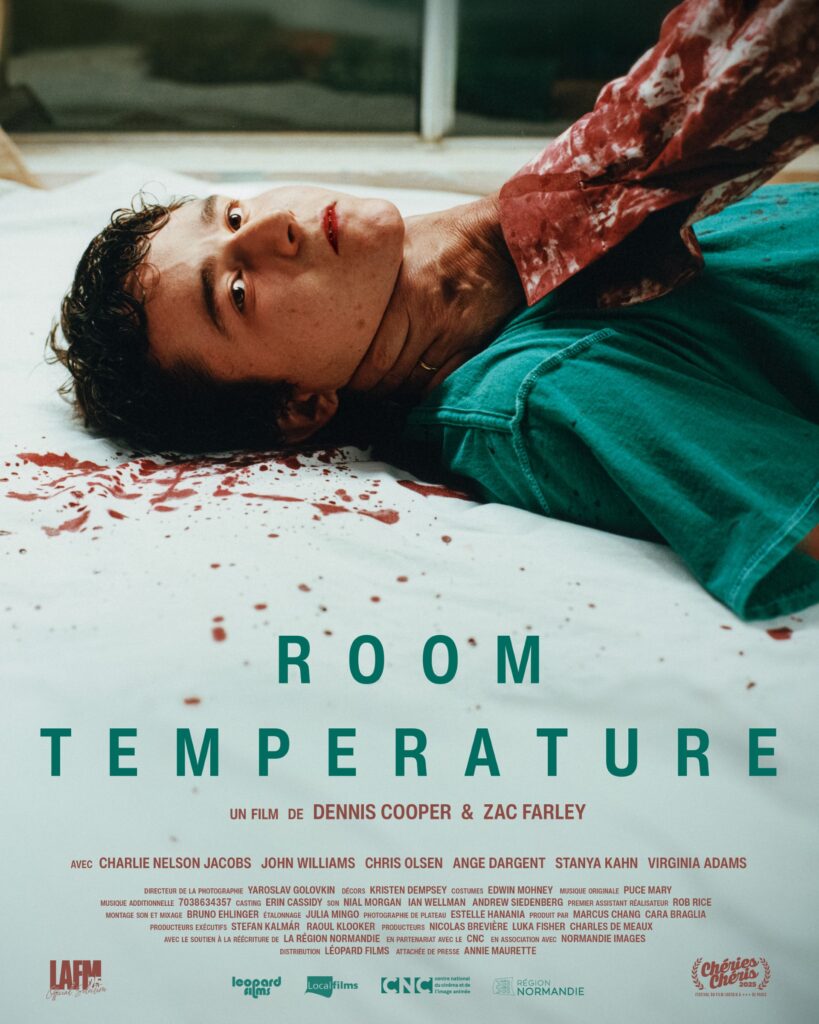



 Now available in North America
Now available in North America 
Hey Dennis,
I’m not special in this, but I do love the look of a CRT tv. I love the glow, the hum, the hiss, and especially the fuzz against your skin, though that’s probably not healthy in the longterm. I watched a few videos that talked about older games, specifically the NES/SNES/64 era of games and how a lot of them were designed around the blur of the photons, and that’s why a lot of those games like Mario look so different and arguably worse nowadays, as the screens themselves show the pixels which were never meant to be so visible. I was supposed to do a photoshoot with one this time last year for a magazine I was creative director of, and have it display the feed from my camcorder, but the TV was way too heavy to lug to my college, and my mother said that it doesnt even work anymore. A shame as it would have really added to the shoot, but it came together nonetheless. I loved Videodrome and that one scene of him entering the tv displaying Debbie Harry’s lips bulging out. I’m looking at the tv in my house now and it’s interesting how TVs are made to look like frames; how even Chromecasts and Amazon Firesticks will display artwork when in standby. I’ve seen people online cover their tvs with openings to make it look like moving pictures in frames. Though I think I will always have a fondness for the big carcinogenic box sat on a floor in a dark room, illuminating with a haunting hissing glow.
I haven’t gone back and listened to Rosalia’s first two albums, though her second album being her college thesis and winning a Grammy is a feat that is impressive. I enjoyed Motomami, not as much as others, but enough that I will come back to it every so often. I saw this throwaway tweet from someone joking that they haven’t listened to Lux since that Twigs album came out (it being only out for a weekend), but I am also in the same boat. I like to gauge how famous someone is based on my mom’s knowledge of them (although when it comes to the 80s-early 00s she has a pretty good knowledge of some random people), and she said she knows the name but couldn’t place her, which is fitting for Twigs. The Pitchfork reviews came out for Afterglow and the reissue of Eusexua: Eusexua back in Jan got a 9.1 or 9.0, which I felt was way too high, and the reissue got an 8.0, which offended a lot of people online though I completely understand that the reasoning is that it makes it seem like she doesn’t have faith in her artwork to be revising it after others’ criticism. In saying all this, I’m not someone who thinks of critics as either complete idiots who don’t know anything, or as the gods who decide what I should think, but I find it slightly frustrating and mostly entertaining at how so many people online treat reviews of art that isn’t even theirs as offensive or an attack on them. I guess it’s an affect of the parasocial nature of celebrity worship? That people see liking a musician less as a hobby or interest and more as a reflection of themselves and who they are as a person?
From reading your takes on films here over the past few months, I’d agree that Pillion wouldn’t be for you haha. Visually the film wasn’t interesting, bar a few POV shots from nighttime motorbike rides (and the amount of ass, erection outlines and Skarsgård body if you’re into that).
The deadline is at 5pm Irish time (or 6pm Paris time) and I’m not going to finish it before then, but I think I accepted on Saturday/Sunday that I wouldn’t get it done for the deadline as it’s becoming something I actually want to put effort into now and not something to just meet a deadline. Thanks for the ‘good’ness, I may send bits on in the future if you’re interested. My main issue right now is trying to form it into something that would be interesting from an outside perspective and not just wholly a reflection of my internal turmoil. And I find that I’ve unconsciously made it follow a Wizard of Oz/Mulholland Drive narrative of bit of story, long dream element that reflects the issues of the character, ending in the real world. Though I don’t necessarily think that’s a bad thing, just that it’s funny and a bit frustrating that theyve seeped into something that was never about that. I’ve been having a lot of wild dreams that I’m taking elements from for the dream bit; one dream was me trying to teach a yoga class for my old secondary school class, with my first big crush being some broody guy who I hate but also want to impress (true to life, except for the broodiness, he was a lot more of a jock ass), and then some other dream about attending some circuit party orgy and me wanting it to be like how it is in porn, except porn never focuses on the real stuff like body hair and the internal rumblings of your digestive system. Plus this fear of being filmed whilst it’s happening… there’s a lot about trying to impress people or wanting to be perfect, which in my present life I’m not dealing with, but definitely in how I think of my future… I’m rambling a lot more than I intended, but aside from the dream bits I really want to combine multiple narrative forms but still make it relatively easy to follow as one voice, which is one of the main reasons I’ve skipped on this deadline as that is something that will need work and refining.
Other than that, been preoccupied with sorting out my room, and trying to fit everything from my rented place into my childhood bedroom. I’ve realized I have some hoarding tendencies as I couldn’t bring myself to throw out old cinema tickets, even ones faded beyond recognition. I have so many books, much more than I can fit in my room, and I’m finding clothes from when I was 16 that will neither fit me nor would I want to wear, yet I keep thinking “what if I want this?”